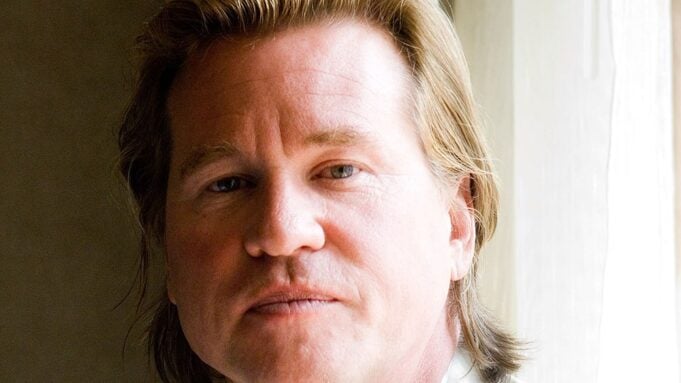Kilmer was a classic camera object in an old-fashioned way. He had a sensual scowl and burning eyes that were very Brando. In “Top Gun,” where he played Iceman, whose job was to bust the chops of Cruise’s Maverick, he was like a malevolent beach bum, the kind of person who won the popularity contest but you couldn’t trust. Iceman had a smile that resembled a bite. Yet he wasn’t the villain; in the end, he came around, harnessing the need for speed in a triumphant way. It was a supporting role, but “Top Gun” became the defining blockbuster of the ’80s, and Kilmer was in orbit, with all the natural-born aristocratic goods of a movie star.
From the moment he was launched, though, he had a relationship to stardom that was profoundly and, in some ways, tragically ambivalent. He wanted to be a force on the big screen, to be a major actor. He’d gone to Juilliard and, in 1983, appeared on the Broadway stage in the hot-ticket production of “The Slab Boys,” opposite Sean Penn and Kevin Bacon. These were the new stars, and they all wanted a certain cred to go along with the fame and the glamour. But Kilmer, whose life was scarred by tragedy (it started when he was a teenager, when one of his brothers died in a jacuzzi after suffering an epileptic fit), wasn’t as on point as those other stars about how the play the game. It was his destiny to follow his bliss, but also to make eccentric choices about what movies to do…and then to try to scramble back into the mainstream with even more questionable choices. His career was never a smooth ride.
If you want to see how smart and fast, how this-dude-has-got-it-all Val Kilmer was as a young actor, just check out “Real Genius,” the 1985 geek-chic comedy directed by Martha Coolidge that’s one of the under-seen gems of the decade. He plays a science wizard at Pacific Tech who becomes the mentor to a 15-year-old prodigy, and Kilmer glides through the movie like an elfin jock in fuzzy animal slippers, living on a cloud of superiority, bringing the perfect note of fake seriousness to lines like “I was thinking of the immortal words of Socrates, who said, ‘I drank what?’” The entire performance is a loop of spinning sarcasm that expresses, in early form, Kilmer’s distrust of the stardom that was about to come to him. If the rom-com had been reinvented in the mid-’80s, “Real Genius” shows you that Vilmer could have been a master of it. But that was not his fate. Instead, he signed on to do “Willow,” a George Lucas-Ron Howard production that seemed like a good move on paper, but the movie was a dud, and it left him floundering.
It was the ghost of Jim Morrison who came to the rescue. When Oliver Stone cast Kilmer to star in “The Doors,” which was essentially a Morrison biopic, he was placing the actor on the highest of wires. How could anyone hope to embody the insolence, the sun-god swagger, the mysterioso essence of the rock star of rock stars? But Kilmer brought it off, playing Morrison as the splendid Dionysian wreck he was, and part of what made him so amazing was the kinship at the core of it: Jim Morrison, like Kilmer, was an all-American beauty on the outside with flaked-out poetic depths on the inside, and Kilmer, in a performance for the ages, went all the way in portraying Morrison’s alternating current of glory and self-destruction.
This, in 1991, was the reboot of Kilmer’s moment. He made the most of it, playing an awesome Elvis in “True Romance” (1992), then giving one of his most indelible performances in the Western epic “Tombstone” (1993), where he played the gambler and gunslinger Doc Holliday as a delectable dandy, chewing the scenery with a relish that only concealed his hidden depths. By the time Doc, stricken with tuberculosis, is lying on his deathbed, the movie has become “Camille” in spurs, and Kilmer owns it.
With “Tombstone,” Kilmer was practically announcing — to the world and to himself — that he was one of those “character actors in a leading man’s body.” And that, in a strange way, is the quality that powered his performance in “Batman Forever” (1985), which may, after “Top Gun,” be the one bull’s-eye blockbuster choice he ever made. It’s not that signing on to that franchise was a slam-dunk (the 1992 Michael Keaton sequel had been a comedown, and the less said about George Clooney and his nipple suit the better). But Kilmer did something smashing with it. It was really his performance — solemn, haunted, majestic — that first put the dark in the dark knight, launching the template that would go on to define Christian Bale and Robert Pattinson’s takes on the role. It was Kilmer who first captured that Batman himself might have bats in his belfry.
As an actor and star, he was riding high. Except that he wasn’t. Kilmer hated wearing the batsuit — and I mean he literally couldn’t stand wearing that suit of rubber armor, because he felt like he couldn’t move in it and couldn’t hear the other actors, and he felt like a puppet. But this was a literal or metaphorical rejection? Kilmer ditched the “Batman” series, which sounds like he made a noble choice of art over commerce — at least, until you look at the movies he made instead, like the misbegotten “The Island of Dr. Moreau” or the flaccid “The Ghost in the Darkness” or “The Saint” (a cult movie to be sure, but I’m sorry, it’s bad), at which point his star wattage had dissipated.
Love Film & TV?
Get your daily dose of everything happening in music, film and TV in Australia and abroad.
If you watch “Tombstone” now, with its tragic end for Doc Holliday, it’s impossible not to think of Kilmer’s own battle with throat cancer, and the way it brought him down, only to reveal depths of courage and resilience. Most of this was kept quite private, until he wrote “I’m a Huckleberry: A Memoir,” published in 2020, and then a year later came out with “Val,” a documentary centered on the videotapes that Kilmer documented his own life with going back to the early ’80s. I imagine that a great many people are now going to want to seek out that film, and I recommend that you do, because it reveals Kilmer in a highly confessional and self-aware way, confronting both his good choices and his bad choices, as well as his personal traumas (his 1996 divorce from Joanne Whalley tore him apart), and the mystery of who he is as an actor.
For a long time, Kilmer kept his traumas hidden. His illness, diagnosed in 2015, ultimately became the conduit for his dragging a lot of stuff out of the closet. Yet one of the things that great actors do is to use their own trauma in a dramatic way. And the movie, unseen by many, in which Kilmer may have done that most powerfully is “Wonderland,” the 2003 drama in which he portrays the porn star John C. Holmes, who went to an incredibly scary and extreme place of addiction, fallen fame, and violence that was in a certain way all but thrust upon him. What is staggering is how much Kilmer takes this ultimate dark-side-of-stardom legend and rips open his humanity.
But you could also say that Kilmer used his trauma when he made his brief and memorably touching appearance in “Top Gun: Maverick,” reminding us, in his very infirmity, how much we had loved this character, and how much Kilmer’s star had loomed back in the day. In “Val,” Kilmer says with rueful amusement, “For the rest of my life, I will be called Iceman by every pilot at every airport I ever go to.” That’s all because of the singular quality he had: the fire inside the ice.
From Variety US































